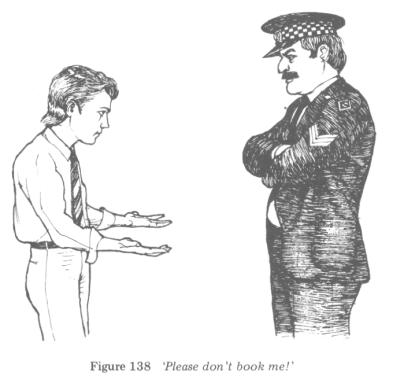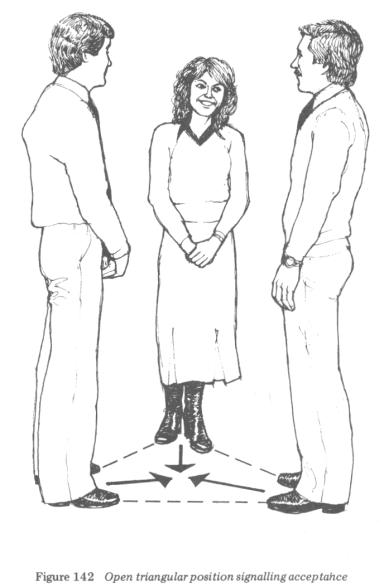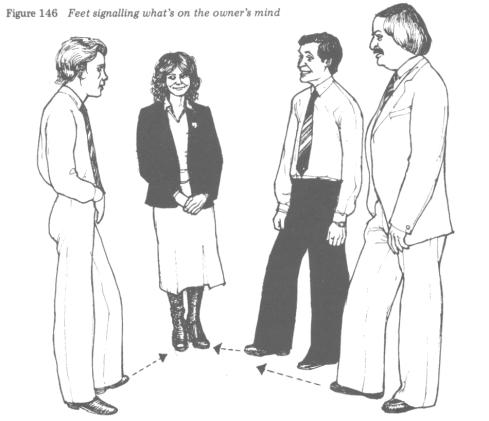Body Language: How to Read Others' Thoughts by Their Gestures (17 page)
Read Body Language: How to Read Others' Thoughts by Their Gestures Online
Authors: Allan Pease
Tags: #Popular psychology, #Advice on careers & achieving success, #Psychology

Fourteen
Body Lowering and Status

Historically, lowering the height of one’s body in front of another person has been used as a means of establishing superior/subordinate relationships. We refer to a member of Royalty as ‘Your Highness’, whereas individuals who commit unsavoury acts are called ‘low’. The protest rally speaker stands on a soapbox to be higher than everyone else, the judge sits higher than the rest of the court, those who live in a penthouse command more authority than those who live at ground level and some cultures divide their social classes into the ‘upper class’ and ‘lower class’.
Despite what many people would like to believe, tall people command more authority than short people, but height can also be detrimental to some aspects of one-to-one communication where you need to ‘talk on the same level’ or have an ‘eye-to-eye’ discussion with another person.
Most women curtsey when they meet Royalty and men incline their heads or remove their hats, making themselves appear smaller than the Royal person. The modern salute is a relic of the act of body lowering. The more humble or subordinate an individual feels towards another, the lower he stoops his body. In business, the people who continually ‘bow’ to the management are labelled with such derogatory name tags as ‘bootlickers’ or ‘crawlers’.
Unfortunately, little can be done to help people become taller or shorter, so let us explore some useful applications of height.
It is possible to avoid intimidating others by consciously making yourself appear smaller in relation to them, so let us examine the non-verbal aspects of the situation in which you have been speeding in your car and are stopped by the police. In these circumstances, the officer may regard you as an adversary as he approaches your vehicle, and a driver’s usual reaction is to remain in the car, wind the window down and make excuses for having exceeded the speed limit. The nonverbal negatives of this behaviour are: (1) The officer is forced to leave his territory (the patrol car) and come across to your territory (your vehicle). (2) Assuming that you have in fact broken the speed limit, your excuses may represent an attack to the officer. (3) By remaining in your car, you create a barrier between yourself and the policeman.

Considering that under these circumstances the police officer is obviously in a superior position to you, this type of behaviour only serves to make things go from bad to worse and your chances of being booked are increased. Instead, try this if you are flagged down: (1) Get immediately out of your car (your territory) and go over to the police officer’s car (his territory). In this way he is not inconvenienced by having to leave his territory. (2) Stoop your body over so that you are smaller than he is. (3) Lower your own status by telling the officer how foolish and irresponsible you are and raise his status by thanking him for pointing out the your ways and telling him that you realise how difficult his job must be with fools like you around. (4) With your palms out, in a trembling voice, ask him not to give you a ticket. This type of behaviour shows the police officer that you are not a threat to him and often causes him to take the role of an angry parent, in which case he gives you a stern warning and tells you to be on your way - without a speeding ticket! When this technique is used as directed, it can save you from being booked more than 50 per cent of the time.
The same technique can be used to calm an irate customer who is returning some faulty goods to a retail store. In this case, the counter represents a barrier between the store owner and the customer. Control of an irate customer would be difficult if the storekeeper remained on his own side of the counter, and this staking-out of territory would make the customer angrier. The best approach would be for the storekeeper to come around to the customer’s side of the counter with his body stooped over and palms visible and to use the same technique as was used with the police officer.
Interestingly, there are some circumstances under which lowering the body can be a dominance signal. This is where you slouch down and make yourself comfortable in an easy chair in another person’s home while the owner is standing. It is the complete informality on the other person’s territory that communicates the dominant or aggressive attitude.
It is also important to remember that a person will always be superior on his own territory, especially in his own home, and submissive gestures and behaviour are very effective methods for getting the person on side with you.
Fifteen
Pointers
 Have you ever had the feeling that someone to whom you are talking would rather be elsewhere than with you, even though he or she seems to be enjoying your company? A still photograph of that scene would probably reveal the following: (1) The person’s head is turned towards you and facial signals such as smiling and nodding are evident. (2) The person’s body and feet are pointing away from you, either towards another person or towards an exit. The direction in which a person points his or her torso or feet is a signal of where he or she would prefer to be going.
Have you ever had the feeling that someone to whom you are talking would rather be elsewhere than with you, even though he or she seems to be enjoying your company? A still photograph of that scene would probably reveal the following: (1) The person’s head is turned towards you and facial signals such as smiling and nodding are evident. (2) The person’s body and feet are pointing away from you, either towards another person or towards an exit. The direction in which a person points his or her torso or feet is a signal of where he or she would prefer to be going.
Figure 139 shows two men talking in a doorway. The man on the left is trying to hold the other man’s attention, but his listener wishes to continue in the direction to which his body is pointing, although his head is turned to acknowledge the other man’s presence. It is only when the man on the right turns his body towards the other that a mutually interesting conversation can take place.
It is noticeable that often in negotiations, when one person has decided to terminate the negotiation or wants to leave, he will turn his body or swing his feet to point towards the nearest exit. If you see these signals during a face-to-face encounter, you should do something to get the person involved and interested or else terminate the conversation on your terms, which allows you to maintain the control.
ANGLES AND TRIANGLES
Open Formation
In an earlier chapter, we stated that the physical distance between people is related to their degree of intimacy. The angle at which people orient their bodies also gives many non-verbal clues to their attitudes and relationships. For example, people in most English speaking countries stand with their bodies oriented to form an angle of 90 degrees during ordinary social intercourse. Figure 140 shows two men with their bodies angled towards an imaginary third point to form a triangle. This also serves as a nonverbal invitation for a third person to join in the conversation by standing at the third point. The two men in Figure 140 are displaying similar status by holding similar gestures and posture and the angle formed by their torsos indicates that an impersonal conversation is probably taking place. The formation of the triangle invites a third person of similar status to join the conversation. When a fourth person is accepted into the group a square will be formed and for a fifth person, either a circle or two triangles.

Closed Formation
When intimacy or privacy is required by two people, the angle formed by their torsos decreases from 90 degrees down to 0 degrees. A man wishing to attract a female partner uses this ploy, as well as other courtship gestures, when he makes his play for her. Not only does he point his body towards her, but he also closes the distance between them as he moves into her intimate zone. To accept his approach, she need only orient her torso angle to 0 degrees and allow him to enter her territory. The distance between two people standing in the closed formation is usually less than that of the open formation.
In addition to the usual courtship displays, both parties may mirror each other’s gestures if they are interested in each other. Like some other courtship gestures, the closed formation can be used as a non-verbal challenge between people who are hostile to each other (see Figure 106).

Inclusion and Exclusion Techniques
Both the open triangular position and the closed position are used to include or exclude another person from the conversation. Figure 142 shows the triangular formation taken by the first two to show acceptance of the third.
When a third person wishes to join two others who are standing in a closed formation, he may be invited to join the conversation only when the other two orient their torsos towards a mutual third point to form the triangle. If the third person is not accepted, the others will hold the closed formation position and turn only their heads towards him or her as a sign of recognition of the third person’s presence but the direction of their torsos shows that he is not invited to remain (Figure 143).

Often a conversation among three people may begin in the open triangular formation but eventually two may take the closed formation position to exclude the third person (Figure 143). This group formation is a clear signal to the third person that he should leave the group to avoid embarrassment.
Seated Body Pointing
Crossing the knees towards another person is a sign of acceptance or interest in that person. If the other person also becomes interested, he or she will cross knees towards the first person, as shown in Figure 144. As the two people become more involved with each other they will begin to copy each other’s movements and gestures, as is the case in Figure 144, and a closed formation results that excludes all others, such as the man on the right. The only way in which the man on the right could participate in the conversation would be to move a chair to a position in front of the couple and attempt to form a triangle, or take some other action to break the formation.


Interviewing Two People
Let us assume that you, person C, are going to interview or talk to persons A and B, and let us say that by either choice or circumstance you are sitting in a triangular position at a round table. Let us also assume that person A is very talkative and asks many questions and that person B remains silent throughout. When A asks you a question, how can you answer him and carry on a conversation without making B feel excluded? Use this simple but highly effective inclusion technique: when A asks a question, look at him as you begin to answer, then turn your head towards B, then back to A, then to B again until you make your final statement, looking at A (who asked the question) again as you finish your sentence. This technique lets B feel involved in the conversation and is particularly useful if you need to have B on side with you.
table. Let us also assume that person A is very talkative and asks many questions and that person B remains silent throughout. When A asks you a question, how can you answer him and carry on a conversation without making B feel excluded? Use this simple but highly effective inclusion technique: when A asks a question, look at him as you begin to answer, then turn your head towards B, then back to A, then to B again until you make your final statement, looking at A (who asked the question) again as you finish your sentence. This technique lets B feel involved in the conversation and is particularly useful if you need to have B on side with you.
Foot Pointing

Not only do the feet serve as pointers, indicating the direction in which a person would like to go, but they are also used to point at people who are interesting or attractive. Imagine that you are at a social function and you notice a group of three men and one very attractive woman (Figure 146). The conversation seems to be dominated by the men and the woman is just listening. Then you notice something interesting - the men all have one foot pointing towards the woman. With this simple non-verbal cue, the men are all telling the woman that they are interested in her. Subconsciously, the woman sees the foot gestures and is likely to remain with the group for as long as she is receiving this attention. In Figure 146 she is standing with both feet together in the neutral position and she may eventually point one foot toward the man whom she finds the most attractive or interesting. You will also notice that she is giving a sideways glance to the man who is using the thumbs-in-belt gesture.